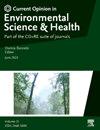气候变化加剧微塑料污染:环境行为和人类健康风险
IF 6.6
Q1 ENVIRONMENTAL SCIENCES
Current Opinion in Environmental Science and Health
Pub Date : 2025-02-25
DOI:10.1016/j.coesh.2025.100608
引用次数: 0
摘要
气候变化和微塑料污染的趋同构成了双重环境威胁,对生态系统和人类健康产生重大影响。气候变化通过改变洋流、温度上升和极端天气事件等机制加速了微塑料的分布,增加了以前未受影响地区和大气中的微塑料浓度。变暖导致冰川融化释放的微塑料进入海洋,并影响干旱条件下土壤微塑料的分布。极端天气事件,如飓风,进一步分散微塑料,使其对环境的影响复杂化。在洪水等气候驱动的事件中,微塑料污染了食物和水源,引发了对水安全和食品安全的严重关切。此外,微塑料与其他新出现的污染物之间的相互作用加剧了环境和健康风险。这项研究强调,迫切需要建立纳入气候因素的风险评估框架,并采取战略管理方法来应对气候变化和微塑料污染的复合影响。通过建议加强水处理、土壤管理、系统监测和毒理学评估,该研究倡导采取综合的全球应对措施,以减轻这些相互关联的生态系统和公共健康保护挑战。本文章由计算机程序翻译,如有差异,请以英文原文为准。

Climate change exacerbates microplastic pollution: Environmental behavior and human health risks
The convergence of climate change and microplastic pollution poses a dual environmental threat with significant impacts on ecosystems and human health. Climate change accelerates microplastic distribution through mechanisms like altered ocean currents, rising temperatures, and extreme weather events, increasing microplastic concentrations in previously unaffected regions and the atmosphere. Warming contributes to microplastics released from melting glaciers into oceans and affects soil microplastic distribution under drought conditions. Extreme weather events, such as hurricanes, further disperse microplastics, complicating their environmental impact. The contamination of food and water sources with microplastics during climate-driven events, such as flooding, raises serious concerns about water security and food safety. Additionally, interactions between microplastics and other emerging pollutants heighten environmental and health risks. This study highlights the urgent need for risk assessment frameworks that incorporate climate factors and for strategic management approaches to address the compounded impact of climate change and microplastic pollution. By recommending enhanced water treatment, soil management, systematic monitoring, and toxicological assessments, the research advocates for integrated global responses to mitigate these interconnected challenges for ecosystem and public health protection.
求助全文
通过发布文献求助,成功后即可免费获取论文全文。
去求助
来源期刊

Current Opinion in Environmental Science and Health
Medicine-Public Health, Environmental and Occupational Health
CiteScore
14.90
自引率
0.00%
发文量
92
审稿时长
114 days
 求助内容:
求助内容: 应助结果提醒方式:
应助结果提醒方式:


